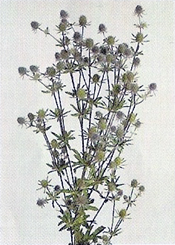







(Planum) (Blue Bell) (Orion) (Supernova)
Eryngium
Nome Botanico: Eringium Maritimum.
Famiglia: Ombrelliferae.
Breve Descrizione: E' conosciuta anche con i nomi di: "Calcatreppola marittima", "Eligio marittimo" e "Cardo stellario marittimo". Pianta erbacea perenne, delle Ombrelliferae (o Apiaceae), con robusto rizoma, priva di peli, coriacea e spinosa, comune lungo le coste e sulle spiagge. Il fusto eretto (alto 50-60 cm) è robusto, ramificato, di colore grigio-verde, provvisto alla base di foglie picciolate, con lamina suborbicolare o reniforme, divisa in 3-5 lobi, coriacea, con margine sinuosamente dentellato e spinoso. Le foglie superiori sono di colore grigio-verde con tonalità azzurrine o violacee.
Durata: Perenne.
Periodo Di Fioritura: All'apice del fusto e all'ascella delle foglie, da giugno a settembre, spuntano le infiorescenze ad ombrella contratta formata da capolini subglobosi che misurano da 2 a 4 cm, di colore bluastro, protetti da 4-6 brattee spinose, ovato-lanceolate con poche spine acute. I piccoli fiori ermafroditi e profumati del capolino sono di colore violetto, formati da 5 sepali rigidi ed eretti e 5 petali più brevi del calice. Il frutto è un poliachenio ovoidale provvisto di uncini superficiali per la disseminazione.
Area Di Origine: Originaria delle coste mediterranee e dell'Atlantico, arriva a nord fino alla Gran Bretagna. Preferisce però le zone centro-mediterranee, vegeta sulle sabbie e dune litorali.
Clima: Mite.
Uso: E' una pianta officinale.
Botanical Name: Eringium Maritimum.
Family: Ombrelliferae.
Brief Description: It is also known under the names: "caltrop sea", "Eligio Sea" and "Cardus Stellario sea." A perennial herb, of Ombrelliferae (or Apiaceae), with tough rhizome, hairless, leathery and spiny, common along the coasts and beaches. The erect stem (50-60 cm high) is robust, branched, gray-green, fitted at the base of leaves petiolate, lamina suborbicolare or kidney-shaped, divided into 3-5 lobes, leathery, with a serrated margin sinuous and thorny. The upper leaves are gray-green with bluish or purplish hue.
Duration: Perennial.
Flowering Period: At the height of the stem and the leaf axil, from June to September, sticking to the inflorescence umbel contracted formed by subglobose heads which measure 2 to 4 cm, bluish, protected by spiny bracts 4-6 , ovate-lanceolate with a few sharp thorns. The small flowers are hermaphrodite and fragrant violet peeps, consisting of 5 rigid and erect sepals and 5 petals shorter than the calyx. The fruit is a poliachenio ovoid surface provided with hooks for dissemination.
Area Of Origin: Native to the Mediterranean and Atlantic coasts, north to arrive in Britain. But prefers areas Central Mediterranean, vegetation on sand dunes and coastal.
Climate: Mild.
Use: it is a medicinal plant.
FIORI RECISI / CUT FLOWERS (GEN-FEB-MAR)
FIORI RECISI / CUT FLOWERS (APR-MAG-GIU)
FIORI RECISI / CUT FLOWERS (LUG-AGO-SET)
FIORI RECISI / CUT FLOWERS (OTT-NOV-DIC)